Making My Bed(s); The “Best” Tomato
Buckwheat Beds
About a month ago the greenhouse was looking messy as oxalis, grasses, chickweed, and other weeds were starting to carpet the mostly bare ground. An unacceptable situation, considering that a month hence — now — I would need the space for planting in preparation for fall and winter.
The first step back in August was, obviously, to clear away the weeds, pulling almost each and every one out, roots and all. As long as weeds aren’t too overgrown or too abundant, the job is pleasantly satisfying. Moist soil also helps.
Pulling out weeds differs from the usual approach of preparing the soil by tilling it to discombobulate and bury weeds. I avoid tillage because it exposes buried weed seeds to light, which is just what new weeds need to germinate and grow. Tillage also burns up valuable humus and discombobulates not only the soil, but also resident fungi, earthworms, and other beneficial organisms.
I wasn’t ready to plant anything in some of those greenhouse beds a month ago, yet I hate to look at bare soil. (Mother Nature is equally repulsed by bare soil; she clothes it with weeds.) So I planted buckwheat, sprinkling the seeds thickly over the beds.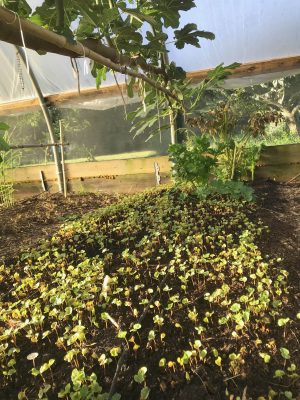 Buckwheat provides a quick and temporary cover of the bare ground. Sprinkling it with water assured its getting off to a quick start.
Buckwheat provides a quick and temporary cover of the bare ground. Sprinkling it with water assured its getting off to a quick start.
Finally, I covered the ground with an inch-thick layer of compost. That amount of compost will nourish whatever’s growing in the beds for a whole year. It also provides cover to hold moisture around the buckwheat.
Only a few days later, buckwheat sprouts were already peeking up through the compost blanket. They went on to grow quickly in the heat of the season. Aboveground the dense foliage was, I hoped, doing its job of shading out any new weeds trying sprout, something for which buckwheat is famous. 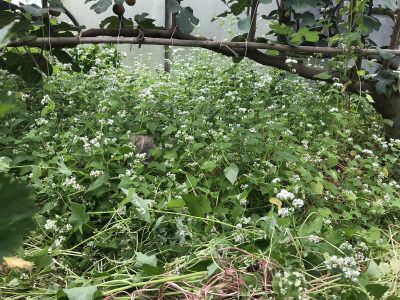 Below ground, the roots were latching onto nutrients that might otherwise leach away, bringing them up into the roots, stems, and leaves.
Below ground, the roots were latching onto nutrients that might otherwise leach away, bringing them up into the roots, stems, and leaves.
By the first week in September, buckwheat stems were flopping down onto the ground. Anyway, it was time to remove them to make way for planting the greenhouse. I was anxious to see what kind of new weed growth, if any, presented itself beneath the buckwheat.
The goal was to remove the buckwheat without disrupting the soil. My fingers easily raked off the tops which detached themselves from the roots that were left intact in the soil.
Buckwheat lived up to its reputation: I could hardly find a weed anywhere!
Oat Beds
Outdoor beds in the vegetable garden have been receiving similar treatment, with some wrinkles. Those beds that are finished for the season, not needed for autumn harvest, get cover crops of oats rather than buckwheat. Buckwheat doesn’t like cool weather and is killed by the slightest frost.
The advantage of oats over buckwheat is that oats enjoy cool weather, growing lush and green, and even tolerate quite a bit of cold weather. 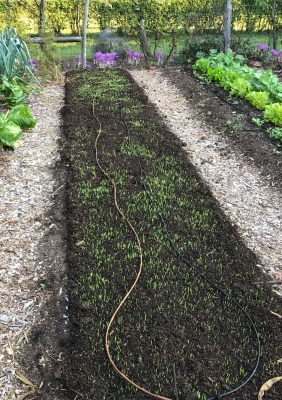 So any bed no longer needed for autumn vegetables and cleared before about the end of September gets oats (and compost). After the end of September, short days don’t provide enough light for the oats to grow enough to warrant planting.
So any bed no longer needed for autumn vegetables and cleared before about the end of September gets oats (and compost). After the end of September, short days don’t provide enough light for the oats to grow enough to warrant planting.
One benefit of oats, buckwheat, and any other cover crop is that they keep up appearances. 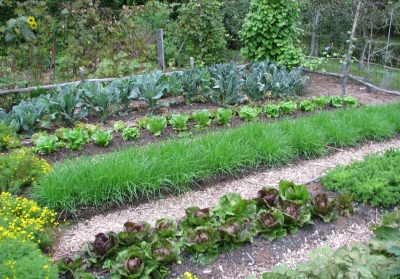 While I have great respect for soil, it’s not pretty to look at — and being bared isn’t good for the soil or the plants growing in it. I’d much rather look at a uniform, green carpet than bare, brown soil.
While I have great respect for soil, it’s not pretty to look at — and being bared isn’t good for the soil or the plants growing in it. I’d much rather look at a uniform, green carpet than bare, brown soil.
The Best(!!!!) Tomato
No need to rush summer vegetables out the door quite yet. I had the opportunity to try out a new tomato this season, Garden Gem, which has received a lot of fanfare.
Time travel back to 1995, when tomato breeder Harry Klee of the University of Florida, began to suss out what makes a great-tasting tomato using heirloom varieties, gas chromatography, and tasting panels. Then fast-forward to 2011, a field in Florida, where Harry tastes the result of his effort to breed a great-tasting tomato that is disease resistant and productive, and stands shipping. And so was born Garden Gem, the offspring of the luscious heirloom variety Maglia Rosa and the variety Fla. 8059, excellent in all characteristics except flavor.
Garden Gem scored as high as the heirloom parent for flavor.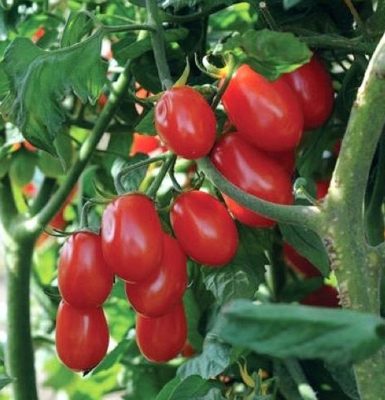 As it turns out, even taste is a matter of taste: To me, Garden Gem is not a great-tasting tomato; not even a good-tasting tomato. It lacked any sweetness or richness to smooth out the acidity, which is basically all I tasted.
As it turns out, even taste is a matter of taste: To me, Garden Gem is not a great-tasting tomato; not even a good-tasting tomato. It lacked any sweetness or richness to smooth out the acidity, which is basically all I tasted.
(The “perfect supermarket tomato,” as it was billed, was also a commercial flop, for now at least. It’s reported that Garden Gem too large for a small tomato and too small for a large tomato and, anyway, that consumers don’t really care about flavor.)

